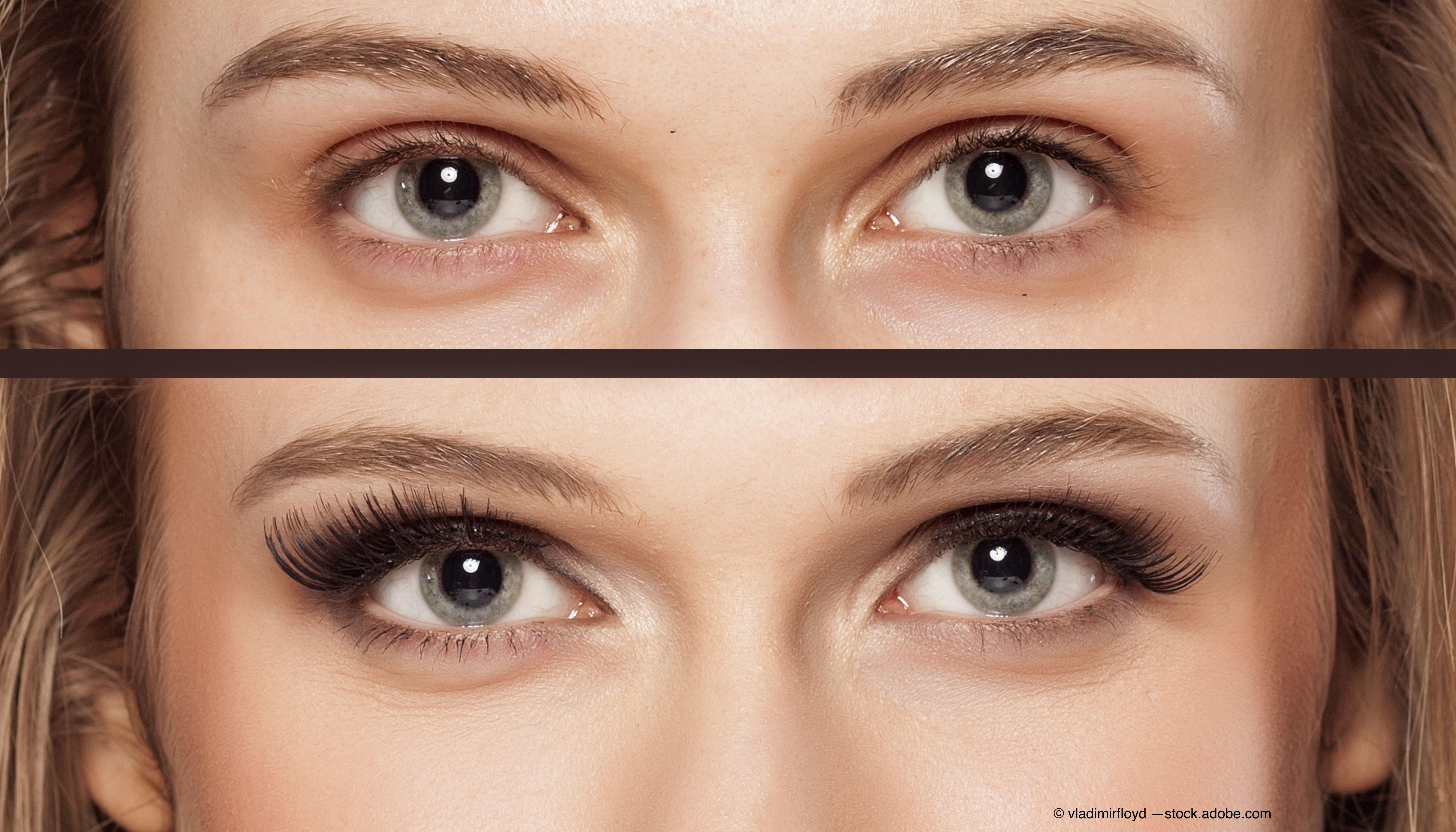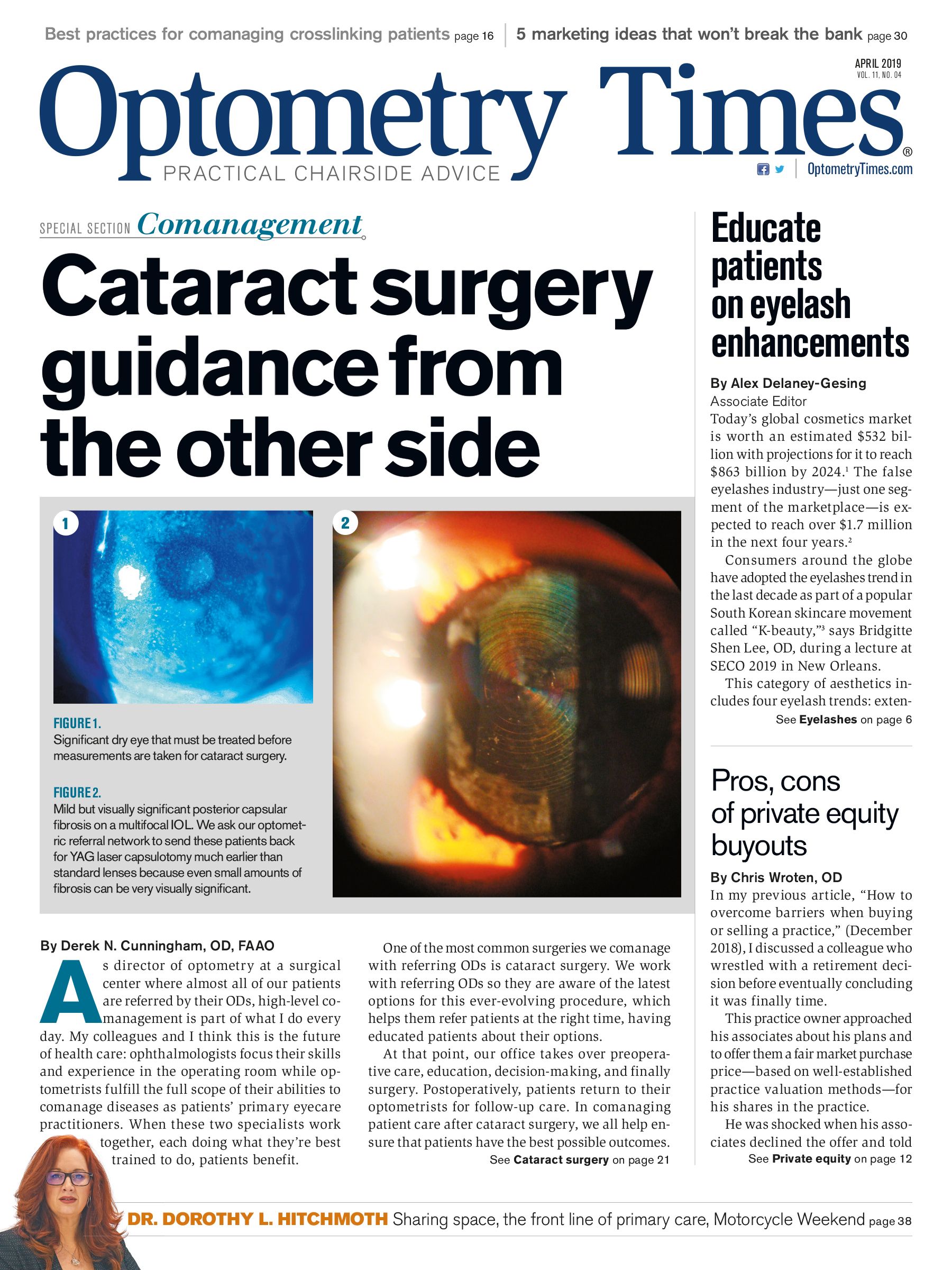How to educate patients on risks of eyelash enhancements

Today’s global cosmetics market is worth an estimated $532 billion, with projections for it to reach $863 billion by 2024.1 The false eyelashes industry-just one segment of the marketplace-is expected to reach over $1.7 million in the next four years.2
Consumers around the globe have adopted the false eyelashes trend in the last decade as part of a popular South Korean skincare movement called “K-beauty,”3 says Bridgitte Shen Lee, OD, during a lecture at SECO 2019 in New Orleans.
This category of ocular aesthetics includes four types of eyelash trends: extensions, falsies, lifts/tints, and growth serums. But with each category of enhancements comes possible ocular surface complications, Dr. Shen Lee says.
For ODs with patients who use fake eyelash products, education is key. Knowledge of each option, the potential side effects, and proper treatment for such manifestations can ensure optimal results.
Eyelash extensions
Eyelash extensions involve gluing a cluster of false lashes onto human eyelashes-a process typically taking three to four hours. An initial session can cost as much as $400, Dr. Shen Lee says. Customers should ideally return for a refill every two weeks, costing $50 per visit.
Related: 4 steps to beating blepharitis
Common ocular surface complications found extension users include:4
• Dermatitis
• Conjuctivitis
• Blepharitis
• Demodex (eyelash mites)
• Dry eye symptoms (itchiness, inflammation)
• Meibomian gland dysfunction (MGD)
• Madarosis (natural eyelash loss)
Women who develop such complications likelly do not clean their eyes and wear makeup over the extensions, according to Dr. Shen Lee. “They often do not want to pay $50 to get a refill [of eyelashes] more often when they should,” she says.
If these patients continue to practice unhealthy eyelash management, their worst case scenario is developing madarosis and severe dry eye or ocular surface disease.
The goal, Dr. Shen Lee says, is to catch patients at the beginning of their eyelash extension sessions to teach them proper management.
Related: Cosmetic dangers: Part 1-Popular cosmetics patients use
Eyelash falsies
Falsies are a cluster or whole strip glued onto the eyelid margin, going over the lashes. Nowadays, eyelashes are often glued under the natural eyelashes to create more of a “lifting” effect, Dr. Shen Lee says.
One of the safer procedures with falsies uses a magnetic eyelash to avoid side effects similar to those of eyelash extensions. This involves placing two strips of eyelashes with tiny magnets at the top and bottom on either side of a human eyelash.4
However, the glue used to attach falsies onto human lashes are made with cyanoacrylate (as an adhesive) and formaldehyde or formaldehyde derivatives. The chemicals are major culprits behind ocular side effects-similarily seen with extensions-on the skin and eyes.
Additional side effects can include corneal abrasions, keratitis (from chemical contact), and compensating incomplete blinks (from weight of lashes).
Lift and tint
Patients with naturally long eyelashes and fairer skin interested in lash enhancement are recommended to receive eyelash lifts (also referred to as permanent waves) or tints.
Lifts involve using strong alkali chemicals like ammonium thioglycolate to semi-permanently curl or “lift” lashes on cylindrical rod.
Tinting involves dyeing lashes using para-phenylenediamine (PPD)5-part of a chemical class called aromatic amines-commonly found in permanent hair dyes. An alternative form of eyelash lift is known as “Japanese lash perm,” in which a speed bump-like device is used to lift the lashes up from the base.4
Unlike extensions, these processes are typically repeated every two to three months as opposed to bi-weekly.
Recommend patients to use a reputable beauty salon and seek care with their OD (not urgent care) if they develop irritation.
Related: Cosmetic dangers: Part 2-Products banned by the FDA, worsen ocular surface disease
Growth serums
Dr. Shen Lee noted several growth serums currently on the market: Latissee (Allergan, Rx-required prostaglandin), popular over-the-counter (OTC) lash enhancers (non-Rx), and Boost Lash Intensifying Serum (OCuSoft, non-Rx).4
Latisse is made with prosteglandin, a main ingredient in glaucoma medication. Potential side effects associated with use of prostaglandin include:
• Conjunctival and eyelid hyperemia
• Burning or irritation
• Prostaglandin periorbitopathy
• Loss of periorbital fat
• Eye color change
A 2016 study on the association of prostaglandin use with MGD found that patients who had prolonged use of prostaglandin had a higher prevelance of MGD.6
“A lot of patients using growth serums with prostaglandin are in this category,” Dr. Shen Lee says.”If these patients have dry symptoms and you have meibography, take a baseline photo the first time you see them and track their meibomian glands over the years.”
Over a dozen OTC lash enhancers are available in the current market, according to Dr. Shen Lee. These feature synthetic prostaglandin (isopropyl cloprostenate) as a main ingredient with similar potential side effects associated as that of the prostaglandin-made Latisse.
Boost Lash Intensifying Serum by OcuSoft includes a patented polypeptide as a main ingredient. No long-term prostaglandin side effects have been reported by users, Dr. Shen Lee says.
“For women who use eyelash serum, it’s important for them to continue to use it - just like skincare products; you can’t just use one bottle and then stop,” she says.
Most eyelash serums work within a few weeks, Dr. Shen Lee says.
Related: The connection between dry eye and eye lashes
Side effects treatment
Depending on the ocular complication a patient develops, Rx and non-Rx medications are available, Dr. Shen Lee says.
Conjunctivitis/red eye
• Lumify (brimonidine, Bausch + Lomb): it's important to treat initial underlying ocular surface disease (OSD) symptoms first
• Rx steroid drops: Alrex or Lotemax (Bausch + Lomb)
• Rx combination drops: Zylet (Bausch + Lomb); Tobradex (Alcon )
• Overall OSD/dry eye management
Dermatitis
• Lotemax ointment (Bausch + Lomb; Rx)
• TobraDex ointment (Alcon; Rx)
Keep the lids and lashes clean can help with treating blepharitis and demodex, Dr. Shen Lee says. She recommends using scrubs and foam wash products such as:
• OCuSoft
• Cliradex (Bio-Tissue)
• We Love Eyes
• Oasis
• Zocular
• Blephex
Related: Demodex may be beneficial to humans
Hypochlorous acid
Dr. Shen Lee advises using three hyperchlorous acid products for lid and lash cleaning:
• Avenova (NovaBay; Rx)
• Acuicyn (Sonoma Pharma; Rx)
• Hypochlor (Ocusoft)
• OcuBliss
• Zenoptiq (Focus Laboratories)
Rx eye drops (dry eye disease)
• Restasis (0.05% cyclosporin; Allergan)
• Xiidra ( 5% lifitigrast; Shire)
• Cequa (0.09% cyclosporin; Sun Pharmaceuticals)
• Genesis (amniotic membrane drops; Ocular Science)
• Generic 0.05% cyclosporine
Related: Preparing the periocular region for surgery
MGD
• LipiFlow (TearScience, Johnson & Johnson Vision)
• Mibo Thermoflow
• Intense pulsed light (IPL, Lumenis)
• iLux (Alcon)
• TearCare (Sight Sciences)
• ThermiEyes (Thermi)
In-office treatment
For patients who present signs of OSD or MGD, Dr. Shen Lee says education and communication are key in providing care.
Read more by Alex Delaney-Gesing
References:
1. Cosmetic Products Market by Product (Skincare products, Haircare products, Color Cosmetics, Fragrances, Personal care products, and Oral care products), by Form (Solutions, Creams, Lotions, Ointments, Suspensions, Tablets, Powders, Gels, Sticks, and Aerosols), by Application (Lips, Eyes, Eyebrows, Nails, and Face), by Distribution Channel (Online, Beauty salons, Specialty stores, Direct selling, Departmental stores, Pharmacy, and Supermarkets), by Region (North America, Europe, Asia Pacific, Latin America, and the Middle East & Africa) - Global Industry Perspective, Comprehensive Analysis and Forecast, 2017 – 2024. Zion Market Research. Available at: https://www.zionmarketresearch.com/report/cosmetic-products-market. Accessed 3/1/19.
2. False eyelashes market research report – forecast to 2023. Market Research Future. Available at: https://www.marketresearchfuture.com/reports/false-eyelashes-market-2921. Accessed 3/4/19.
3. Shin L. Inside the booming Korean skincare market. Fast Company. Available at: https://www.fastcompany.com/3038283/why-korean-skincare-is-booming. Accessed 3/4/19.
4. Shen Lee B. Ocular aesthetics: Lash obsessions. Eyecare Business. Available at: https://www.eyecarebusiness.com/issues/2018/september-2018/ocular-aesthetics. Accessed 2/27/19.
5. Campaign for safe cosmetics. P-phenylenediamine. Available at: http://www.safecosmetics.org/get-the-facts/chemicals-of-concern/p-phenylenediamine/. Accessed 2/27/19.
6. Mocan MC, Uzunosmanoglu E, Kocabeyoglu S, Karakaya J, Irkec M. The association of chronic topical prostaglandin analog use with meibomian gland dysfunction. J Glaucoma. 2016 Sep;25(9):770-4.

Newsletter
Want more insights like this? Subscribe to Optometry Times and get clinical pearls and practice tips delivered straight to your inbox.